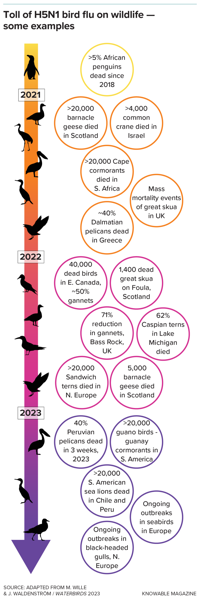A steep toll on wildlife
- Knowable Magazine
- Updated
- 0


Regardless of whether H5N1 jumps from person to person sooner, later or never, it's raging in wild animals. In the U.S., thousands of birds of more than 160 native species, including mallards, sparrows, pigeons and bald eagles, . So have hundreds of mammals of more than two dozen native species, . Some of these get sick, and some die.
Many of these infections are "dead ends," Richards notes: They don't pass the virus on. It's mainly far-flying ducks that have done that.
By late 2022, H5N1 had entered South America and was thundering down the continent's Pacific coast. "It then traveled the 6,000-kilometer spine of South America in six months, so that's very fast for a virus that's not assisted by planes," says Wille. It hit the tip of South America and .
En route, it killed 40 percent of Peruvian pelicans, South American sea lions and southern elephant seal pups.
Wild birds have been affected around the world, and even waterbirds, which normally harbor influenza A without symptoms, . Though a full census is lacking, individual examples are sobering. The population of great skuas, found primarily in Scotland, is . An outbreak in California condors in 2023 , in a species with fewer than 1,000 in existence. "An event like that could change the course of a species," says Wille. "Are they going to come back or not?"
H5N1 hasn't reached Australia or New Zealand, but Wille thinks it's just a matter of time. For the world, the future of this virus, with its propensity to defy expectations, is up in the air. "I think we're on the precipice of something," says Wille. "What that something is, I'm not sure."
was produced by and reviewed and distributed by Stacker.
Knowable MagazineTags
As featured on
Knowable Magazine answers questions about how dangerous bird flu is, where it came from, and…
Currently in Carterville


